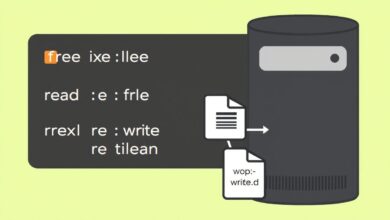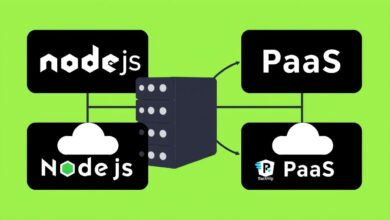Apache vs Nginx: A Beginner’s Guide to Choosing Your Web Server

When you decide to host a website or web application, one of the fundamental components you’ll need is a web server. This software is responsible for accepting requests from web browsers (like Chrome, Firefox, or Safari) and delivering the requested content (like HTML pages, images, or videos) back to them. Two of the most popular and powerful web servers dominating the internet landscape are Apache and Nginx. For beginners entering the world of web hosting, understanding the differences between Apache vs Nginx is crucial to making an informed decision.
Both Apache HTTP Server and Nginx (pronounced “engine-x”) have proven their reliability and capability over years, powering a vast majority of websites globally. However, they were designed with different architectures and excel in different areas. This guide will break down their core features, performance characteristics, configuration styles, and common use cases to help you choose the right web server for your specific needs.
Meet the Contenders: Apache and Nginx
Let’s start with a brief introduction to each.
Apache HTTP Server: The Enduring Veteran
Apache is the oldest and arguably the most widely used web server software for many years. Developed by the Apache Software Foundation, it’s known for its flexibility, robustness, and extensive feature set, largely thanks to its vast collection of modules. Apache uses a process-based architecture, where it typically spawns a new process or thread to handle each incoming connection. This model has been very effective but can sometimes consume more resources under heavy load compared to newer architectures.
One of Apache’s significant advantages for beginners is its decentralized configuration. You can configure certain aspects of the server on a per-directory basis using .htaccess files placed within content directories. This is incredibly convenient, especially in shared hosting environments or for projects where you need granular control without modifying the main server configuration files.
NGINX: The Modern Challenger
NGINX was initially developed to address the C10k problem (handling 10,000 concurrent connections) and is built with performance and scalability in mind. Unlike Apache’s process-based model, Nginx uses an event-driven, asynchronous architecture. This means it can handle many connections within a single thread or process, making it highly efficient, lightweight, and capable of handling a large volume of concurrent requests with minimal resource consumption.
While Nginx can serve web content directly, it truly shines when handling static files, acting as a reverse proxy, load balancer, or HTTP cache. Its configuration is centralized, typically managed through a few core configuration files. This centralized approach can be less intuitive for beginners used to .htaccess but offers a clearer, more performant way to manage configurations at scale.
Apache vs Nginx: Key Comparison Points
Comparing web servers involves looking at several factors. Here’s how Apache and Nginx stack up:
- Performance & Architecture: This is perhaps the most significant difference.
- Apache: Process/thread based. Can be resource-intensive under high concurrent connections. Handles dynamic content efficiently within the server process itself (e.g., with PHP modules like mod_php).
- NGINX: Event-driven, asynchronous architecture. Highly efficient and lightweight, excellent at handling many concurrent connections and static files. Often passes dynamic content requests to external processors (like PHP-FPM). Performance benchmarks often show Nginx delivering static content significantly faster. One comparison showed Nginx with loading speeds of 24.15MB/s versus Apache’s 4.09MB/s, highlighting its speed advantage in certain scenarios.
- Configuration:
- Apache: Decentralized via
.htaccessfiles. Easy for per-directory overrides, less efficient as it requires the server to check directories for config files. - NGINX: Centralized configuration files. Requires server reload/restart for changes. Cleaner and more performant but less flexible for quick, localized changes by non-root users.
- Apache: Decentralized via
- Flexibility & Modules:
- Apache: Extremely flexible with a vast library of dynamic modules (e.g., mod_rewrite, mod_ssl) that can be enabled/disabled easily without server restarts for many configurations.
- NGINX: Modules are generally compiled into the Nginx core or loaded as dynamic modules (a newer feature). It’s less flexible than Apache’s vast array but covers most common functionalities needed for modern web serving and proxying.
- Community & Documentation:
- Apache: Benefits from a very long history and a massive, mature community. Documentation is extensive and widely available, making it a great starting point for beginners.
- NGINX: Has a rapidly growing and active community. Documentation is excellent, though perhaps not as vast as Apache’s simply due to its shorter history. Nginx has surpassed Apache in popularity according to some surveys, indicating its strong current adoption.
- Security: Both servers are secure when properly configured. Security depends more on the administrator’s practices (updates, configuration) than inherent flaws in the server software itself.
Use Cases: When to Choose Which?
Given their differences, Apache and Nginx are often best suited for different tasks, although there’s significant overlap:
- Choose Apache if:
- You are a beginner and want ample documentation and a large community for support.
- You need extensive flexibility and reliance on
.htaccessfiles for per-directory configurations (e.g., shared hosting environments). - You are primarily serving dynamic content and want tight integration with languages like PHP via modules (like mod_php).
- You need specific modules or functionalities that are more mature or only available in the Apache ecosystem.
- Choose NGINX if:
- You need to handle high traffic volumes and many concurrent connections efficiently.
- Performance and scalability are your top priorities, especially for serving static content.
- You plan to use the server as a reverse proxy, load balancer, or HTTP cache in front of other application servers.
- You prefer a centralized, performance-oriented configuration approach.
- You are building or running modern web applications where performance under load is critical.
It’s also worth noting that it’s common practice to use both together. Nginx can act as a fast front-end reverse proxy handling static files and traffic distribution, while Apache handles the backend processing for dynamic content requests. This leverages the strengths of both servers.
Both servers are compatible with various software to form a complete web stack, such as the popular LAMP (Linux, Apache, MySQL, PHP) or LEMP (Linux, Nginx, MySQL, PHP) stacks. They both work well with content management systems like WordPress, though Nginx is often cited for providing improved performance for WordPress sites, especially under load.
For more on setting up a web stack, you might find our guide on Setting Up Your First Website on a Server (LAMP/LEMP/WIMP Stack Basics) helpful.
Making Your Decision
Ultimately, the choice between Apache and Nginx depends on your specific requirements, technical comfort level, and the type of content you’ll be serving. For many beginners starting with a simple website or blog, Apache’s ease of configuration with .htaccess and extensive documentation might make it a slightly gentler entry point. However, if you anticipate high traffic or plan to use advanced features like reverse proxying, Nginx offers compelling performance and scalability benefits that are hard to ignore.
Consider factors like the degree of customization required versus the demands for performance and scalability. Evaluate their performance, compatibility with your chosen technologies, security considerations, available features, and ease of configuration from your perspective as a beginner. Market trends show Nginx’s increasing dominance, especially for high-performance scenarios. You can see web server usage statistics on sites like W3Techs to observe current trends.
Conclusion
Both Apache and Nginx are excellent, free, open-source web servers powering millions of websites worldwide. Neither is inherently “better” than the other; they are different. Apache offers flexibility and ease of configuration for many common use cases, while Nginx provides superior performance and scalability, particularly for static content and as a proxy. By understanding their core differences in architecture, configuration, and typical use cases, beginners can confidently choose the web server that best aligns with their project goals and technical skills.
[Hint: Insert image/video summarizing key differences or showing both logos]



